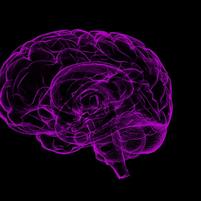Dementia afflicts over 50 million people worldwide, and the numbers affected will rise as more people survive to old age. The emotional costs to the sufferer and the carer are huge, as are the economic costs - estimated worldwide as US $818 billion, and the costs will increase with increasing longevity. It is imperative, therefore, that effective treatments are found.
Most AD researchers investigate the disease’s main features – amyloid plaques and neurofibrillary tangles, which are abnormal protein deposits in AD brains. However, despite the vast amount of information gathered about these structures, the causes of their formation are unknown, and despite the vast amount of funding provided for clinical trials combating amyloid formation, on the basis that it is the cause of the disease, all the trials have unfortunately proved unsuccessful.
One alternative cause – a common virus - has been strongly implicated as playing a major role in the disease, by research carried out in my laboratory. The results indicate a direct route to treatment: effective and safe antiviral agents are available to combat the virus and thus to treat AD patients. They indicate also the future possibility of preventing the disease by vaccination against the virus in infancy. The virus implicated, herpes simplex virus type 1 (HSV1), is the one that causes cold sores. It infects most humans and thereafter remains lifelong in the body in latent (i.e., dormant) form within the peripheral nervous system (the part of the nervous system other than the brain and spinal cord). From time to time, for example if the person is stressed, the virus becomes activated and causes an acute infection which, in some people, causes visible damage in the form of cold sores.
In 1991, my laboratory discovered that in many elderly people the virus is present also in brain. This was the first microbe to be found definitively in human brain. Subsequently, we discovered that it confers a strong risk of AD when in the brain of people who have a specific genetic factor - the type 4 allele (form) of the gene, APOE, which codes for a protein called apoE4. The likelihood of developing AD is 12 times greater for APOE4 carriers who have HSV1 in brain than for those without either factor.
HSV1 DNA was found in brain of a high proportion of normal elderly people as well as AD patients, but this does not invalidate a role for the virus. Response to a microbe - i.e., an individual's susceptibility to infection, and/or the extent of damage if infection ensues - can differ from person to person, and is determined by genetic factors or immune responses; outcome can range from uninfected or asymptomatic infection to severe or fatal illness, so that an infected but asymptomatic person might be classed as a “control”. This concept is now more familiar to most people than in the past, because asymptomatic infection has been shown to occur also in COVID-19. In the case of HSV1, this would mean that the virus is usually latent in brain but as in the peripheral nervous system, it can be activated, perhaps recurrently, and it then causes direct damage and also damaging inflammation.
Subsequently, we linked HSV1 directly to AD plaques and tangles. We discovered that the viral DNA is located very specifically within plaques of AD brains. We found also that the main component of plaques, a small protein called beta amyloid (Aβ), accumulates in HSV1-infected cell cultures, and in the brains of HSV1-infected mice. Taken together, these results suggest that HSV1 is a cause of toxic amyloid products and plaques. We showed too that the main component of tangles – an abnormal form of the protein called tau – accumulates in HSV1-infected cell cultures. Subsequent work by other groups confirmed and extended these data on HSV1-induced Aβ and abnormal tau. One possibility is that infected cells produce Aβ and abnormal tau as part of their “innate” immune system, in an attempt to protect against HSV1, but eventually overproduce them and they then cause damage. Alternatively, cells may produce them because they are needed by HSV1 for its replication: when activated, the virus subverts the cell’s protein-making machinery so that instead of making cell proteins, the machinery makes viral proteins, hence enabling production and then spread of whole new viruses - with consequent cellular damage.
We propose that HSV1 is a major contributory factor for AD, entering the brain in the elderly as their immune system declines during ageing, and establishing a latent infection there, from which it is reactivated by events such as stress, immunosuppression, and brain inflammation induced by systemic infection. Repeated activation causes cumulative damage, leading eventually to the development of AD, in people with an APOE4 allele. (Other studies of ours support the concept that genetic factors can determine the severity of damage caused by a microbial infection: in fact we have shown that APOE affects outcome of infection caused by several diverse microbes, the most relevant being that APOE4 is a risk for cold sores; this explains why only some 25% of the many people – the APOE4 carriers infected with HSV1 suffer from cold sores.) Presumably, in APOE4 carriers, there is greater HSV1-induced formation of toxic products, or lesser repair of damage, the same applying to cold sores.
The data suggest that antiviral agents might be used for treating AD. Our experiments using antiviral agents to HSV1-infected cells in culture showed that they are indeed protective against the formation of amyloid and tau. We found also that on using the main antiviral agents, which act by targeting HSV1 DNA replication, together with a certain substance which blocks viral entry into cells, the effect is synergistic - greater than the sum of their individual contributions.
We conclude that anti-HSV antiviral agents would slow or stop disease progression, with the great advantage that unlike current therapies, only the virus, not the host cell, would be targeted. Also, other viral damage besides Aβ and P-tau production that might be involved in AD pathogenesis would be inhibited. The above results are supported by well over 200 publications by other groups, using very diverse approaches, and the number of supportive papers is steadily increasing. For much of the last 30 years, the role of infectious agents in the disease, in particular that of HSV1, was ignored, derided, or virulently opposed (though opponents provided no scientific arguments). Obtaining grants and publishing papers was a huge battle. Fortunately, though, the situation is now improving because of the recent large increase in supportive data. Hopefully, the opponents will eventually realise that this virus is as insidious as the SARS-CoV-19 virus and affects many more people worldwide, condemning them to what is effectively a slow living “death”; funding should then become available for research and for clinical trials, to alleviate and perhaps prevent this terrible disease.
About the Author:
Professor Ruth Itzhaki is a Visiting Professorial Fellow at the Oxford Institute of Population Ageing.
Opinions of the blogger is their own and not endorsed by the Institute
Comments Welcome: We welcome your comments on this or any of the Institute's blog posts. Please feel free to email comments to be posted on your behalf to administrator@ageing.ox.ac.uk or use the Disqus facility linked below.













